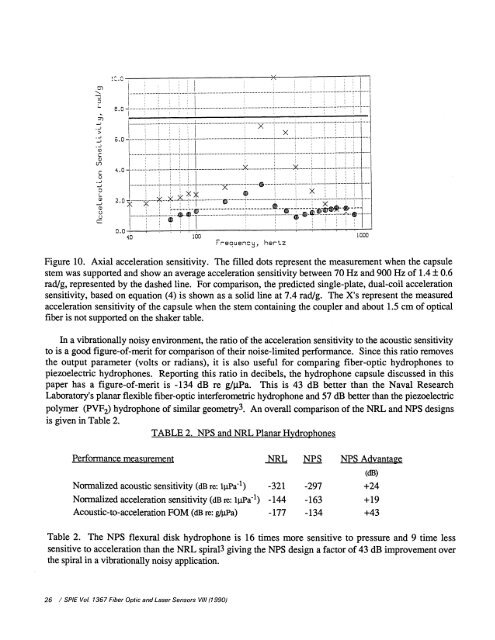A General Purpose Fiber-Optic Hydrophone Made of Castable Epoxy
A General Purpose Fiber-Optic Hydrophone Made of Castable Epoxy
A General Purpose Fiber-Optic Hydrophone Made of Castable Epoxy
You also want an ePaper? Increase the reach of your titles
YUMPU automatically turns print PDFs into web optimized ePapers that Google loves.
ic.D<br />
><br />
.-)<br />
C<br />
Cr)<br />
C<br />
0<br />
.-)<br />
0<br />
a)<br />
a)<br />
0<br />
e.<br />
6.0<br />
4.0<br />
2.0<br />
liii ZI1II 1ZI ZI 1.<br />
x<br />
xXZ)<br />
.<br />
--;-;-<br />
T<br />
0.0<br />
40 ido<br />
.<br />
><br />
Figure 10. Axial acceleration sensitivity. The filled dots represent the measurement when the capsule<br />
stem was supported and show an average acceleration sensitivity between 70 Hz and 900 Hz <strong>of</strong> 1.4 0.6<br />
rad/g, represented by the dashed line. For comparison, the predicted single-plate, dual-coil acceleration<br />
sensitivity, based on equation (4) is shown as a solid line at 7.4 rad/g. The X's represent the measured<br />
acceleration sensitivity <strong>of</strong> the capsule when the stem containing the coupler and about 1.5 cm <strong>of</strong> optical<br />
fiber is not supported on the shaker table.<br />
In a vibrationally noisy environment, the ratio <strong>of</strong> the acceleration sensitivity to the acoustic sensitivity<br />
to is a good figure-<strong>of</strong>-merit for comparison <strong>of</strong> their noise-limited performance. Since this ratio removes<br />
the output parameter (volts or radians), it is also useful for comparing fiber-optic hydrophones to<br />
piezoelectric hydrophones. Reporting this ratio in decibels, the hydrophone capsule discussed in this<br />
paper has a figure-<strong>of</strong>-merit is -134 dB re g/Pa. This is 43 dB better than the Naval Research<br />
Laboratory's planar flexible fiber-optic interferometric hydrophone and 57 dB better than the piezoelectric<br />
polymer (PVF2) hydrophone <strong>of</strong> similar geometry3. An overall comparison <strong>of</strong> the NRL and NPS designs<br />
is given in Table 2.<br />
TABLE 2. NPS and NRL Planar <strong>Hydrophone</strong>s<br />
Performance measurement NRL NPS NPS Advantage<br />
Normalized acoustic sensitivity (dB re: lpPa1) -321 -297<br />
Normalized acceleration sensitivity (dB re: lj.iPa1) -144 -163<br />
Acoustic-to-acceleration FOM (dB re: g/jiPa) -177 -134<br />
x<br />
Table 2. The NPS flexural disk hydrophone is 16 times more sensitive to pressure and 9 time less<br />
sensitive to acceleration than the NRL spiral3 giving the NPS design a factor <strong>of</strong> 43 dB improvement over<br />
the spiral in a vibrationally noisy application.<br />
.<br />
>(<br />
Freauenc, Kertz<br />
.<br />
:<br />
iiiIziiziizI Iz1 1ZI I 11 1<br />
cT .<br />
:<br />
1000<br />
(dB)<br />
+24<br />
+19<br />
+43<br />
26 1 SPIE Vol. 1367 <strong>Fiber</strong> <strong>Optic</strong> and Laser Sensors VIII (1990)

















